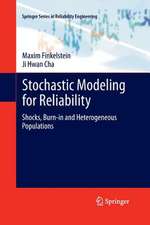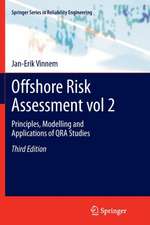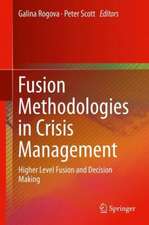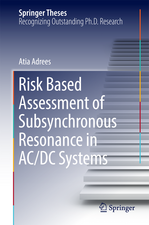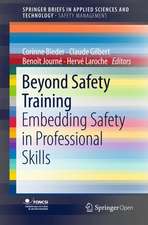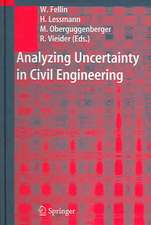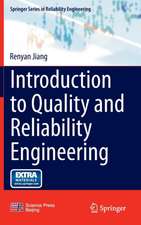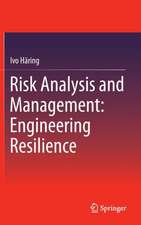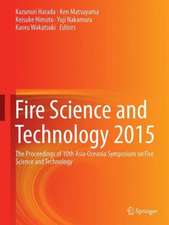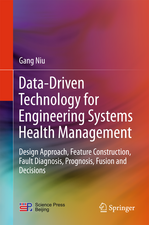Risk Communication for the Future: Towards Smart Risk Governance and Safety Management: SpringerBriefs in Applied Sciences and Technology
Editat de Mathilde Bourrier, Corinne Biederen Limba Engleză Paperback – 6 iul 2018
This book is Open Access under a CC-BY licence.
Din seria SpringerBriefs in Applied Sciences and Technology
-
 Preț: 380.29 lei
Preț: 380.29 lei - 17%
 Preț: 360.34 lei
Preț: 360.34 lei - 20%
 Preț: 386.12 lei
Preț: 386.12 lei -
 Preț: 380.07 lei
Preț: 380.07 lei -
 Preț: 377.95 lei
Preț: 377.95 lei -
 Preț: 382.32 lei
Preț: 382.32 lei -
 Preț: 376.59 lei
Preț: 376.59 lei -
 Preț: 379.09 lei
Preț: 379.09 lei -
 Preț: 378.12 lei
Preț: 378.12 lei - 20%
 Preț: 293.83 lei
Preț: 293.83 lei -
 Preț: 344.90 lei
Preț: 344.90 lei -
 Preț: 321.36 lei
Preț: 321.36 lei -
 Preț: 264.79 lei
Preț: 264.79 lei -
 Preț: 344.90 lei
Preț: 344.90 lei -
 Preț: 356.46 lei
Preț: 356.46 lei -
 Preț: 382.95 lei
Preț: 382.95 lei -
 Preț: 355.66 lei
Preț: 355.66 lei -
 Preț: 479.67 lei
Preț: 479.67 lei -
 Preț: 415.18 lei
Preț: 415.18 lei -
 Preț: 444.52 lei
Preț: 444.52 lei - 20%
 Preț: 301.86 lei
Preț: 301.86 lei -
 Preț: 409.43 lei
Preț: 409.43 lei - 20%
 Preț: 322.17 lei
Preț: 322.17 lei -
 Preț: 355.49 lei
Preț: 355.49 lei - 15%
 Preț: 462.51 lei
Preț: 462.51 lei -
 Preț: 377.18 lei
Preț: 377.18 lei -
 Preț: 355.93 lei
Preț: 355.93 lei -
 Preț: 382.95 lei
Preț: 382.95 lei -
 Preț: 378.12 lei
Preț: 378.12 lei -
 Preț: 378.12 lei
Preț: 378.12 lei -
 Preț: 380.07 lei
Preț: 380.07 lei -
 Preț: 380.07 lei
Preț: 380.07 lei - 20%
 Preț: 326.28 lei
Preț: 326.28 lei -
 Preț: 312.68 lei
Preț: 312.68 lei -
 Preț: 356.43 lei
Preț: 356.43 lei -
 Preț: 412.30 lei
Preț: 412.30 lei - 20%
 Preț: 225.31 lei
Preț: 225.31 lei -
 Preț: 378.12 lei
Preț: 378.12 lei -
 Preț: 376.59 lei
Preț: 376.59 lei -
 Preț: 195.87 lei
Preț: 195.87 lei -
 Preț: 376.22 lei
Preț: 376.22 lei - 20%
 Preț: 324.64 lei
Preț: 324.64 lei - 20%
 Preț: 288.73 lei
Preț: 288.73 lei -
 Preț: 377.57 lei
Preț: 377.57 lei -
 Preț: 261.91 lei
Preț: 261.91 lei -
 Preț: 381.98 lei
Preț: 381.98 lei -
 Preț: 273.64 lei
Preț: 273.64 lei -
 Preț: 410.87 lei
Preț: 410.87 lei -
 Preț: 379.68 lei
Preț: 379.68 lei -
 Preț: 374.30 lei
Preț: 374.30 lei
Preț: 164.05 lei
Nou
Puncte Express: 246
Preț estimativ în valută:
31.39€ • 32.78$ • 25.92£
31.39€ • 32.78$ • 25.92£
Carte tipărită la comandă
Livrare economică 16-30 aprilie
Preluare comenzi: 021 569.72.76
Specificații
ISBN-13: 9783319740973
ISBN-10: 3319740970
Pagini: 126
Ilustrații: VIII, 175 p. 13 illus., 11 illus. in color.
Dimensiuni: 155 x 235 x 15 mm
Greutate: 0.27 kg
Ediția:1st ed. 2018
Editura: Springer International Publishing
Colecția Springer
Seriile SpringerBriefs in Applied Sciences and Technology, SpringerBriefs in Safety Management
Locul publicării:Cham, Switzerland
ISBN-10: 3319740970
Pagini: 126
Ilustrații: VIII, 175 p. 13 illus., 11 illus. in color.
Dimensiuni: 155 x 235 x 15 mm
Greutate: 0.27 kg
Ediția:1st ed. 2018
Editura: Springer International Publishing
Colecția Springer
Seriile SpringerBriefs in Applied Sciences and Technology, SpringerBriefs in Safety Management
Locul publicării:Cham, Switzerland
Cuprins
Foreword, by Mathilde Bourrier and Corinne Bieder.- Introduction: Chapter 1 Risk Communication 101: A Few Benchmarks, by Mathilde Bourrier.- Part I Persuading in Peace Time: A Longlasting Story.- Chapter 2 Public Participation in the Debate on Industrial Risk in France: A Success Story?, by Caroline Kamaté.- Chapter 3 Organizing Risk Communication for Effective Preparedness: Using Plans as a Catalyst for Risk Communication, by Amandine Berger-Sabbatel and Benoit Journé.- Chapter 4 Nuclear Crisis Preparedness: Lessons Learned from Fukushima Daiichi, by Geneviève Baumont.- Chapter 5 Risk Communication between Companies and Local Stakeholders for Improving Accident Prevention and Emergency Response, by Michael Baram and Preben Lindoe.- Part II When Reality Strikes Back: Tough Lessons to be Learned from Crises.- Chapter 6 How Risk Communication Can Contribute to Sharing Accurate Health Information for Individual Decision-Making: An Empirical Study from Fukushima During a Post-EmergencyPeriod, by Mariko Nishizawa.- Chapter 7 Crisis Communication During the Ebola Outbreak in West Africa: The Paradoxes of Decontextualized Contextualization, by Loïs Bastide.- Part III The Collapse of Absolute Trust in Absolute Truth.- Chapter 8 Transparency in Healthcare: Disclosing Adverse Events to the Public, by Siri Wiig, Karina Aase, Olav Røise and Mathilde Bourrier.- Chapter 9 How Safety Communication Can Support Safety Management: The Case of Commercial Aviation, by Michel Guérard.- Chapter 10 Risk Communication from an Audit Team to its Client, by Petra Haferkorn.- Conclusion: Chapter 11 Societal Risk Communication - Towards Smart Risk Governance and Safety Management, by Corinne Bieder.
Textul de pe ultima copertă
The conventional approach to risk communication, based on a centralized and controlled model, has led to blatant failures in the management of recent safety related events. In parallel, several cases have proved that actors not thought of as risk governance or safety management contributors may play a positive role regarding safety. Building on these two observations and bridging the gap between risk communication and safety practices leads to a new, more societal perspective on risk communication, that allows for smart risk governance and safety management.
This book is Open Access under a CC-BY licence.
This book is Open Access under a CC-BY licence.
Caracteristici
Presents viewpoints by leading researchers from a range of scientific disciplines Questions the conventional "centralized views" of risk communication Discusses the challenges inherent to risk communication Proposes a novel perspective on risk communication as a way forward in risk governance and safety management



